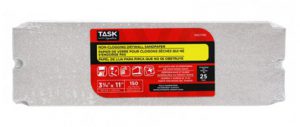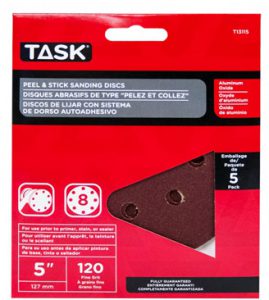Admittedly, all sandpaper looks pretty much identical when it’s in the package. Sometimes people stand there for a while examining the different varieties and wondering what they need for a particular project.
What material is best? When did sandpaper start coming in triangle shapes and iron shapes? And what do all of those numbers even mean?
Don’t worry – we’re here to sand down any confusion. Here’s a quick guide to choosing the right sandpaper for your next project…
The type of abrasive:

- Garnet sandpaper is made from natural abrasives. It’s great for sanding raw wood by hand but it wears down quickly.
- If you’re sanding metal – by hand or using a power-sander – emery sandpaper with cloth backing is the way to go. It’s also a natural abrasive and you can buy packages of individual cloths or a roll of emery cloths.
- Aluminum oxide is a man-made abrasive that lasts a long time and works on a variety of surfaces (wood, plastic, metal, drywall, etc.) so it’s usually the best choice for a power-sander. As you sand with it, the abrasive particles break down which creates sharp new edges.
- Silicon carbide sandpaper wears out faster than aluminum oxide sandpaper but it also works faster. TASK’s waterproof silicon carbide paper is ideal for wet-sanding, which minimizes the scratches on your finished surface. It also cuts down on the dust that clogs the sandpaper and clouds the air in your work area.
- Drywall plaster is easily sanded with just about anything in your sandpaper arsenal but that doesn’t mean it will be a pleasant experience. That fine, white dust can gum up a piece of sandpaper in a matter of seconds.
The shape and style:
Since power-sanders come in all different shapes and sizes, it can be overwhelming the first time you try to buy a sandpaper refill.
Start by determining your sander’s shape – iron, triangle or circle. (A rectangular sander just uses regular sheets and doesn’t require specially-shaped sandpaper.) Then all you need to know is whether your sander has five holes, six holes, eight holes, or no holes at all.
Choosing the refills that are exactly the same shape with the same number of holes means they’ll fit perfectly on the sander that’s waiting for you back at home.
The grit level:

Task circular peel & stick sanding disc
So what’s the ideal “number” for sandpaper? It depends on the project. Sandpaper starts at 40-grit (coarse) and then moves up to 60-80 grit (medium), 100-120 grit (fine) and 120-280 grit (very fine).
Here’s a handy way to remember sandpaper numbering: a smaller number is referring to a smaller number of abrasive particles (which means they’re larger, resulting in a rougher sanding that potentially leaves scratches). The bigger the number, the bigger number of particles – and all of those tiny particles are what will give your project a smooth finish.
The best way to sand is to start with a low-grit paper and work your way up to a high-grit paper for a satiny-smooth finish.
If you have questions about picking the right sandpaper, we’re always happy to help!


